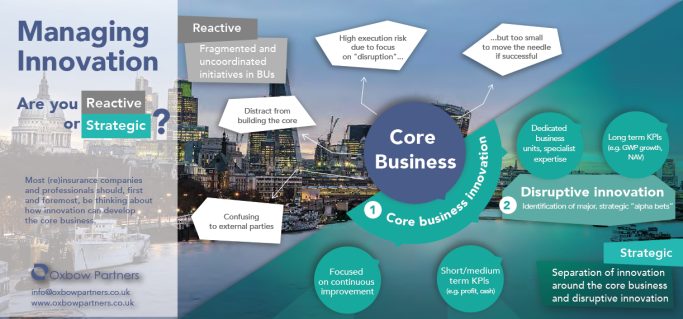Our latest infographic looks at how corporates should organise their innovation activities.
Click on the image to enlarge.
Reactive innovation
We define “reactive innovation” as “fragmented and uncoordinated initiatives in business units”.
We regularly find ourselves speaking to clients who have been challenged to “be more innovative”, but without clear objectives.
We think this is a flawed approach to innovation.
- It focuses on activity not outcomes: The goal is often defined as “partnering with 5 startups” rather than a business outcome like “reduce the loss ratio by 10%”
- The execution risk is high as these initiatives are too far from employees’ core activities and competencies
- The upside is often too small to justify the risk: An obvious example is that one successful startup partnership (hard to arrange in itself) is unlikely to be of any material consequence to a corporate – the value is in building a portfolio of such partnerships, which requires significant focus and resources
- It can be confusing to external parties: “Why are you partnering with startups when the division over there is doing the same?” “Who really understands blockchain round here?”
Overall, reactive innovation means that employees are distracted from building value in the core business and focus excess effort on opportunities that are unlikely to deliver material value.
Strategic innovation
Strategic innovation management divides innovation into two categories.
First of all, there is core business innovation. This is what 99% of staff should be focusing on in most companies in the insurance industry. Employees should be making continuous improvements to the core business proposition – a large number of minor tweaks and enhancements that cumulatively have a high impact. These activities are likely to be compatible with existing performance frameworks – maximising short-term metrics such as profit and cash.
Second, we have defined “disruptive innovation”. We believe that companies should identify a relatively small number of strategic “alpha-bets” in areas where they think they can invest to create real long-term value. These initiatives can be distant from the core business – for example Munich Re’s Digital Partners division or the industry B3i blockchain initiative. In each case, the skills required for success are different, for example experts in new fields, ringfenced resources, and KPIs such as GWP or NAV growth.
With this management structure, companies can ensure that they have the right balance of core business innovation and disruptive innovation, maximising their chances of success.
It is important not to miss value-creating opportunities by focusing excessive effort on disruptive moonshots.



